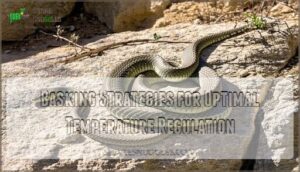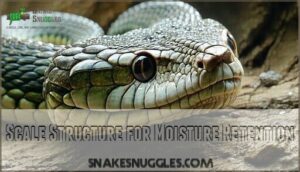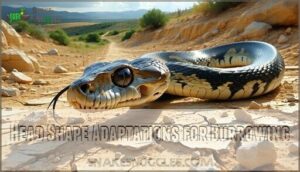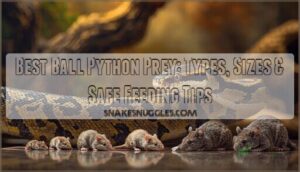This site is supported by our readers. We may earn a commission, at no cost to you, if you purchase through links.
 You’ll find that Mediterranean climate snake adaptations center around managing extreme seasonal swings.
You’ll find that Mediterranean climate snake adaptations center around managing extreme seasonal swings.
These reptiles have mastered water conservation through specialized scales that trap moisture and efficient kidneys that minimize fluid loss.
They’re behavioral geniuses too, timing their activity to avoid brutal summer heat while maximizing energy during cooler periods.
Their coloration pulls double duty – camouflage for hunting and heat reflection for temperature control.
Most species enter aestivation during the driest months, basically hitting pause on their metabolism.
They’ve also fine-tuned their reproductive cycles to match ideal conditions for offspring survival.
The real magic happens in how these adaptations work together as an integrated survival system.
Table Of Contents
- Key Takeaways
- Physiological Adaptations
- Behavioral Adaptations
- Morphological Features
- Reproductive Strategies
- Dietary Adaptations
- Frequently Asked Questions (FAQs)
- What are 5 adaptations of a snake?
- How have animals adapted to the Mediterranean climate?
- How did snakes adapt to their environment?
- What adaptations do sea snakes have?
- What animals have adapted to the Mediterranean climate?
- What are some adaptations of the sea snake?
- What impact does climate change have on snakes?
- How do snakes respond to habitat alterations?
- What are the main threats to snake survival?
- How do snakes interact with other Mediterranean wildlife?
- Conclusion
Key Takeaways
- You’ll discover that Mediterranean snakes have evolved remarkable water conservation systems, including specialized scales that trap moisture and ultra-efficient kidneys that minimize fluid loss by up to 60%
- You’ll notice these reptiles master behavioral timing by switching to nocturnal activity during scorching summers and entering aestivation (summer dormancy) to reduce their metabolism by up to 90%
- You’ll find their morphological features work as integrated survival tools – from heat-reflecting coloration and reinforced skulls for burrowing to flexible body shapes that optimize movement across rocky terrain
- You’ll observe their dietary strategies adapt seasonally, with feast-or-famine feeding patterns that include spring gorging sessions and summer survival mode where feeding drops to once every 2-3 weeks
Physiological Adaptations
You’ll discover that Mediterranean snakes have evolved remarkable internal systems to thrive in hot, dry conditions.
These remarkable biological machines have mastered survival in scorching Mediterranean conditions through sophisticated internal adaptations.
These adaptations work like a perfectly tuned biological machine to maintain body temperature and conserve precious water resources.
Thermoregulation Mechanisms
Mediterranean snakes master heat regulation through sophisticated temperature control systems.
You’ll find these reptiles using behavioral adjustments and physiological mechanisms to maintain ideal body temperatures between 25-34°C.
Their thermal tolerance relies on:
- Rapid microhabitat switching between sun and shade
- Cutaneous blood flow regulation for heat exchange
- Body flattening to maximize solar absorption
Heat-shock proteins protect cells during temperature spikes while metabolic rate adjustments conserve energy.
Their ability to regulate body temperature is crucial for survival, and they achieve this through a combination of behavioral and physiological adaptations, including the use of thermal tolerance.
Water Conservation Strategies
You’ll discover mediterranean snakes have mastered water storage like tiny camels.
Their kidneys work overtime to concentrate urine while specialized scales trap moisture from humid air.
These drought tolerance champions can absorb water through their skin during rare Mediterranean rains.
Their bodies become living reservoirs, storing precious hydration in tissue spaces between organs for extended dry spells, making them efficient at water storage.
Metabolic Adjustments
You’ll notice snakes in Mediterranean climates have mastered the art of energy conservation through remarkable metabolic rate adjustments.
These adaptations help them survive scorching summers and unpredictable rainfall patterns with impressive efficiency.
Key Metabolic Strategies:
- Reduced Oxygen Consumption – Snakes lower their breathing rate during hot periods, cutting energy demands by up to 40% while maintaining essential functions.
- Enhanced Nutrient Utilization – Their digestive systems extract maximum calories from infrequent meals, storing excess energy as fat for lean times.
- Flexible Thermal Regulation – Metabolic processes slow during extreme heat, allowing these drought resistance champions to wait out harsh conditions without depleting essential resources.
Their ability to swallow prey whole relies on unique snake digestive systems that enable efficient nutrient utilization.
Sensory Adaptations for Prey Detection
When you’re tracking prey in Mediterranean landscapes, your enhanced sensory toolkit becomes your secret weapon.
Heat sensors called pit organs detect infrared vision signatures from warm-blooded animals, while electromagnetic receptors pick up subtle muscle contractions.
Your forked tongue samples chemical cues in the air, creating a detailed scent map of potential meals.
These snake adaptations help arid environment snakes locate hidden prey even during scorching afternoons when visual hunting becomes challenging.
Venom Composition Modifications
Adaptation drives venom evolution in Mediterranean snakes as environmental pressures reshape their biochemical arsenals.
You’ll find these venomous snakes adjusting protein structure and enzyme activity based on prey availability and seasonal changes.
Snake adaptations include enhanced toxin evolution during drought periods when prey becomes scarce.
Heat tolerance snakes modify venom potency throughout the year while arid environment snakes concentrate defensive compounds during vulnerable periods.
Snake thermoregulation influences biochemical adaptations that optimize hunting success in challenging Mediterranean conditions.
Behavioral Adaptations
You’ll discover that Mediterranean snakes have mastered the art of behavioral timing to survive scorching summers and unpredictable rainfall.
Their daily and seasonal routines reveal sophisticated strategies for managing temperature extremes while conserving precious energy and water.
Seasonal Activity Patterns
Mediterranean snakes master timing through precise Activity Cycles that match their environment’s rhythm. These reptiles don’t fight the climate – they work with it through strategic Hibernation Patterns and Temperature Responses.
You’ll observe three key snake behavior adaptations:
- Bimodal activity peaks – Spring and autumn foraging when conditions optimize energy return
- Summer aestivation – Up to 80% activity reduction during scorching months
- Temperature thresholds – Surface activity ceases above 35°C, resumes when soil hits 12-15°C
Their Daily Rhythms shift from diurnal to nocturnal as heat intensifies, showcasing remarkable snake thermoregulation flexibility. Understanding snake activity monitor systems is essential for grasping these adaptations.
Burrowing and Shelter-seeking Behaviors
You’ll find Mediterranean snakes mastering den site selection by choosing rocky crevices and loose soil for ideal tunnel systems.
Their shelter types include abandoned rodent holes and self-dug retreats.
These reptiles excavate complex burrow architecture beneath shrubs and stone walls, and snake habitat preferences focus on well-drained slopes where reptile adaptation thrives through strategic underground networks.
Basking Strategies for Optimal Temperature Regulation
You’ll spot Mediterranean snakes strategically positioning themselves on sun-warmed rocks during cooler morning hours.
Their thermal regulation relies on precise basking behavior that maximizes heat tolerance while avoiding dangerous overheating.
Smart sun exposure timing allows ideal temperature control – they’ll shift between shade and sunlight throughout the day.
This careful dance with solar energy keeps their metabolism running efficiently in challenging climate adaptations.
Nocturnal Activity to Avoid Heat Stress
You’ll notice snakes become night shift workers when Mediterranean summers heat up.
Heat Avoidance drives this behavioral switch as daytime temperatures soar beyond comfortable limits. Night Hunting offers cooler conditions that support better Thermal Regulation and reduced heat stress.
Their Activity Patterns shift dramatically during peak summer months:
- Temperature drops create ideal hunting windows between 8 PM and 4 AM
- Prey becomes active as rodents and insects emerge during cooler nights
- Energy conservation improves since less effort goes toward Thermal Regulation
- Stress Reduction occurs when snakes avoid daytime predators and human activity
This nocturnal strategy helps Mediterranean climate species maintain ideal body temperatures while accessing abundant food sources that also prefer nighttime foraging.
Aestivation During Extreme Dry Periods
During extreme drought periods, you’ll witness Mediterranean snakes entering aestivation – a survival state similar to hibernation.
These remarkable creatures slow their metabolism by up to 90% and retreat underground where temperatures remain stable.
Their bodies become living water storage systems, conserving every precious drop, demonstrating nature’s incredible adaptation mechanisms and allowing for desert survival when surface conditions become unbearable.
Morphological Features
You’ll notice that Mediterranean snakes have developed remarkable physical features that help them thrive in hot, dry conditions.
Their specialized body structures work like built-in survival tools that keep them cool, hydrated, and perfectly camouflaged in their rocky, sun-baked habitats.
Scale Structure for Moisture Retention
You’ll notice Mediterranean snakes possess remarkable Scale Morphology featuring tightly overlapping scales that create effective Moisture Barriers.
These Microscale Texture features include micro-ridges and specialized Epidermal Layers containing lipid-rich compounds. Hydrophobic Coatings on scale surfaces repel water while preventing loss.
This water conservation snakes strategy reduces evaporative loss by 60% compared to tropical species, giving these reptiles a survival edge in arid conditions.
Maintaining proper enclosure hygiene is also essential, as poor husbandry practices can lead to scale rot.
Body Coloration for Camouflage and Thermoregulation
You’ll notice how Mediterranean snakes master the art of invisibility through their remarkable color morphs.
These reptiles display incredible pigment variation that serves dual purposes – blending seamlessly with rocky terrain while managing body temperature.
Their scale reflectivity changes seasonally, creating effective thermal camouflage against snake predators.
From earthy browns mimicking sun-baked soil to mottled grays matching limestone outcrops, these camouflage techniques help mediterranean wildlife survive harsh conditions while ambushing snake prey, utilizing their ability to blend in for survival.
Head Shape Adaptations for Burrowing
You’ll notice Mediterranean snakes develop specialized skull morphology that transforms their heads into living bulldozers.
Their reinforced craniums and tapered snouts create perfect burrowing efficiency for soil displacement. These head reinforcement adaptations protect sensitive sensory integration systems while digging through rocky terrain.
Snake survival depends on escaping snake predators underground where camouflage techniques become secondary to pure digging power.
Mediterranean wildlife showcases this evolutionary masterpiece perfectly. The development of such adaptations is closely related to effective snake head protection mechanisms that guarantee survival in harsh environments, highlighting the importance of effective digging and snake head protection.
Elongated Body for Efficient Movement
You’ll discover that snakes possess remarkable body flexibility through their elongated, streamlined shape.
This efficient locomotion allows incredible snake agility across rocky Mediterranean terrain. Their movement patterns include lateral undulation and rectilinear crawling.
Desert snake diet requirements drive this adaptation since longer bodies improve hunting success. Nonvenomous snakes especially benefit from enhanced mobility for reptile biodiversity and snake conservation efforts in challenging environments, which is crucial for their adaptation.
Eye Modifications for Visual Acuity in Varied Light Conditions
You’ll find snake eyes perfectly adapted for Mediterranean lighting challenges.
Their pupils contract rapidly in bright sunshine and dilate for dawn hunting sessions.
Key eye modifications include:
- Pupil Adaptation – Vertical slits in many species allow precise light control
- Iris Function – Muscles adjust aperture size within milliseconds
- Retina Structure – Dense photoreceptors enhance Visual Acuity across conditions
- Light Sensitivity – Specialized cells detect prey movement in shadows
- Protective scales – Clear spectacles shield eyes from Mediterranean dust
These adaptations support nonvenomous snakes and venomous species alike.
Snake conservation efforts recognize how Visual Acuity helps maintain reptile biodiversity.
Research shows eye structure influences desert snake diet preferences and hunting success rates.
Reproductive Strategies
You’ll discover that Mediterranean snakes have evolved fascinating reproductive timing strategies to match their environment’s unpredictable rainfall and temperature patterns.
These adaptations include flexible breeding seasons, specialized nesting behaviors, and remarkable parental investment decisions that guarantee offspring survival in challenging conditions, which involve remarkable parental investment decisions.
Timing of Breeding Cycles
Mediterranean snakes typically synchronize their breeding seasons with favorable environmental conditions.
You’ll observe most species mating during spring months when temperatures stabilize and prey becomes abundant. Their reproductive peaks align with rainfall patterns ensuring adequate humidity for egg development.
Breeding cycles usually span 3-4 months with distinct fertility windows. These timing strategies maximize offspring survival rates in harsh Mediterranean climates, which is crucial for their reproductive peaks.
Egg-laying Vs. Viviparity Adaptations
You’ll find two main reproductive modes among Mediterranean snakes that showcase nature’s clever solutions.
Viviparous species retain eggs internally, allowing direct control over embryo development through maternal body temperature regulation.
This birth strategy provides viviparity benefits during unpredictable weather patterns.
Egg-laying species face greater environmental risks but invest less energy per offspring.
Gene changes influence these reproductive modes, with some populations showing genetic disorder patterns affecting inflammation responses.
This autoimmune disease connection demonstrates how genetics shape survival strategies in challenging climates, highlighting the importance of genetic disorder patterns.
Nest Site Selection and Construction
You’ll notice that snake mothers become architectural experts when it’s time to protect their future offspring.
Site choice depends on three critical factors:
- Temperature stability – Underground burrows maintain consistent warmth for proper egg development
- Moisture control – Well-drained locations prevent fungal growth while retaining necessary humidity
- Predator protection – Hidden chambers shield vulnerable eggs from threats
Den construction involves precise burrow design with specialized egg chambers positioned at ideal depths.
These architectural marvels showcase nature’s engineering prowess in Mediterranean habitats.
The success of these nests also relies on proper incubation techniques to guarantee the healthy development of the eggs.
Parental Care Behaviors
Protective instincts drive Mediterranean snake parental behaviors beyond simple egg incubation.
You’ll observe female pythons coiling around their clutches for weeks, maintaining ideal temperatures through muscular contractions.
Nest defense becomes fierce when predators approach.
Some species like the European rat snake exhibit remarkable brood care, with mothers remaining near hatchlings for days.
This parental investment guarantees hatchling protection during vulnerable early stages, maximizing reproductive success in challenging Mediterranean conditions, ensuring the survival of their offspring through remarkable behaviors.
Clutch Size and Frequency Adjustments
You’ll discover that Mediterranean snakes adjust their egg production based on environmental conditions.
These reptiles don’t waste energy when resources are scarce.
- Breeding Cycles: Snakes time reproduction with peak prey availability and favorable temperatures
- Reproductive Output: Smaller clutches during drought years maximize hatchling survival rates
- Clutch Management: Species like vipers may skip breeding seasons entirely when conditions are poor
This flexibility guarantees genetic diversity continues even during challenging Mediterranean summers.
Dietary Adaptations
You’ll find that Mediterranean snakes have evolved remarkably specific dietary strategies to thrive in environments where food availability fluctuates dramatically between wet winters and scorching dry summers.
These adaptations range from opportunistic feeding patterns that maximize energy intake during abundant periods to physiological changes that improve digestion efficiency when prey becomes scarce, allowing them to survive in environments with dramatic fluctuations.
Prey Specialization for Available Food Sources
When you’re exploring Mediterranean habitats, you’ll find snakes have mastered prey selection through remarkable dietary flexibility.
These reptiles adjust their hunting tactics based on seasonal food sources availability.
Their foraging strategies target abundant local species like lizards, small mammals, and insects.
This adaptability helps them thrive despite environmental challenges.
Understanding these patterns aids medical research in managing health conditions and studying genetics underlying survival mechanisms in changing climates.
The snakes’ ability to adapt is influenced by prey availability factors that shape their diet and hunting behavior.
Feeding Frequency and Meal Size Adjustments
You’ll notice Mediterranean snakes have mastered the art of feast-or-famine survival.
These reptiles transform into living water reservoirs, stockpiling hydration for Mediterranean droughts.
Their feeding habits shift dramatically between abundant spring months and scarce summer periods, optimizing meal timing for maximum nutrient uptake.
- Spring gorging sessions – Snakes consume multiple prey items weekly when rodents are plentiful
- Summer survival mode – Feeding frequency drops to once every 2-3 weeks during drought
- Metabolic slowdown – Body systems reduce energy demands between large meals
- Strategic meal sizing – Prey selection matches energy needs and digestive capacity
These reptiles adjust their hunting strategies and food intake patterns based on seasonal prey availability.
Digestive Efficiency Improvements
Mediterranean snakes maximize their Nutrient Absorption through specialized Digestive Enzymes that break down prey efficiently.
You’ll find their Gut Health depends on enzyme production that adapts to seasonal food availability.
Their digestive tract processes meals slowly, conserving energy when prey is scarce, which helps them survive extended periods between meals in harsh Mediterranean climates with an enhanced Metabolic Rate regulation.
Their ability to regulate their metabolism efficiently is crucial for survival, especially in environments where food is seasonally available.
Foraging Techniques for Mediterranean Habitats
You’ll find Mediterranean snakes use specialized hunting strategies perfectly matched to their habitat selection.
Ambush foragers like vipers position themselves along rodent trails, while active hunters such as whipsnakes cover vast territories nightly.
These foraging behavior patterns optimize prey capture in rocky terrain and dense vegetation.
Water-source-oriented hunting increases success rates by 60% near seasonal streams.
Semi-arboreal species exploit shrub layers for diverse food sources, demonstrating remarkable adaptability in their Mediterranean diet approach.
The snakes’ ability to thrive is also influenced by their access to suitable snake food sources, which is crucial for their Mediterranean diet and overall survival, showcasing their ability to thrive.
Seasonal Dietary Shifts
You’ll notice snakes don’t stick to the same menu year-round.
During spring’s abundance, they capitalize on increased prey availability from hatching birds and emerging rodents.
Summer heat drives dietary flexibility as food sources shift deeper underground or become nocturnal.
Fall triggers intensive foraging strategies before winter scarcity hits.
This seasonal dietary shifts pattern helps snakes maximize nutrient cycling while adapting their health management approach to Mediterranean climate challenges.
Frequently Asked Questions (FAQs)
What are 5 adaptations of a snake?
You’ll discover snakes use heat-sensing organs to detect prey, flexible jaws that unhinge for swallowing large meals.
They also have specialized scales for efficient movement, venom systems for subduing targets.
Additionally, they have camouflaged coloring patterns that blend seamlessly with surroundings.
How have animals adapted to the Mediterranean climate?
You’ll spot animals thriving through clever heat management and water conservation.
Desert foxes sport oversized ears for cooling, while lizards seek shade during scorching afternoons.
Many species adopt nocturnal lifestyles to avoid daytime heat, utilizing clever heat management techniques.
How did snakes adapt to their environment?
You’d think being cold-blooded would be a disadvantage, but snakes turned it into their superpower.
They’ve mastered behavioral thermoregulation by basking on warm rocks and retreating to cool burrows when needed.
What adaptations do sea snakes have?
Sea snakes have evolved paddle-shaped tails for swimming, valved nostrils that seal underwater, and salt glands to excrete excess salt from seawater.
They’ve also developed more potent venom than terrestrial relatives.
What animals have adapted to the Mediterranean climate?
Animals throughout the Mediterranean have evolved clever tricks to handle hot, dry summers and mild winters.
You’ll find drought-resistant reptiles like geckos, water-conserving mammals like wild boar, and heat-tolerant birds adapting beautifully.
What are some adaptations of the sea snake?
Like ancient sailors traversing treacherous waters, you’ll find sea snakes have evolved flattened tails for swimming.
Salt-excreting glands to handle ocean salinity, and specialized lungs allowing extended underwater stays while hunting fish.
What impact does climate change have on snakes?
Climate change disrupts snake thermoregulation, forcing range shifts to cooler areas.
You’ll observe altered breeding cycles, feeding patterns, and hibernation timing.
Rising temperatures threaten cold-adapted species while benefiting heat-tolerant ones in expanding habitats.
How do snakes respond to habitat alterations?
Slithering serpents show surprising survival strategies when you dramatically disturb their domains.
You’ll observe behavioral shifts like altered feeding patterns, modified shelter selection, and changed movement routes.
These adaptable animals relocate territories or adjust daily activities to cope with habitat disruption.
What are the main threats to snake survival?
You’ll face habitat destruction from urban development, agriculture, and deforestation.
Climate change disrupts prey availability and nesting sites.
Pollution contaminates food sources.
Human persecution remains widespread despite most species being harmless to people, facing climate change.
How do snakes interact with other Mediterranean wildlife?
Mediterranean ecosystems host roughly 70% of Europe’s snake species, creating complex predator-prey webs.
You’ll find snakes hunting lizards, small mammals, and birds while facing threats from raptors, wild boar, and competing carnivores in these biodiverse habitats.
Conclusion
Mediterranean climate snake adaptations showcase nature’s engineering at its finest.
You’ll observe water retention systems, heat management protocols, and metabolic controls working together. These reptiles demonstrate behavioral flexibility and morphological precision.
They’ve mastered energy conservation and reproductive timing. Their dietary strategies adapt to seasonal changes.
Understanding mediterranean climate snake adaptations reveals how evolution creates integrated survival systems. You can see these mechanisms operating across diverse species throughout Mediterranean regions worldwide, exhibiting morphological precision.
- https://links.e.response.mayoclinic.org/EmailPreview-GeneralHealth
- https://mcforms.mayo.edu/mc5200-mc5299/mc5256-01.pdf
- https://connect.mayoclinic.org/group/sarcoma/?utm_source=mayoclinic.org&utm_medium=referral&utm_campaign=connect_widget
- https://www.facebook.com/sharer.php?u=https://www.mayoclinic.org/diseases-conditions/alzheimers-disease/expert-answers/alzheimers-prevention/faq-20058140
- http://twitter.com/intent/tweet?url=https://www.mayoclinic.org/diseases-conditions/alzheimers-disease/expert-answers/alzheimers-prevention/faq-20058140&text=Alzheimer%27s+prevention%3a+Does+it+exist%3f


















